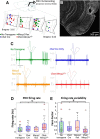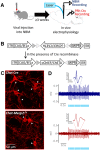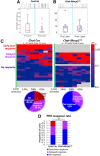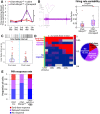Mecp2 Deletion from Cholinergic Neurons Selectively Impairs Recognition Memory and Disrupts Cholinergic Modulation of the Perirhinal Cortex
- PMID: 31562178
- PMCID: PMC6825959
- DOI: 10.1523/ENEURO.0134-19.2019
Mecp2 Deletion from Cholinergic Neurons Selectively Impairs Recognition Memory and Disrupts Cholinergic Modulation of the Perirhinal Cortex
Abstract
Rett Syndrome is a neurological disorder caused by mutations in the gene encoding methyl CpG binding protein 2 (MeCP2) and characterized by severe intellectual disability. The cholinergic system is a critical modulator of cognitive ability and is affected in patients with Rett Syndrome. To better understand the importance of MeCP2 function in cholinergic neurons, we studied the effect of selective Mecp2 deletion from cholinergic neurons in mice. Mice with Mecp2 deletion from cholinergic neurons were selectively impaired in assays of recognition memory, a cognitive task largely mediated by the perirhinal cortex (PRH). Deletion of Mecp2 from cholinergic neurons resulted in profound alterations in baseline firing of L5/6 neurons and eliminated the responses of these neurons to optogenetic stimulation of cholinergic input to PRH. Both the behavioral and the electrophysiological deficits of cholinergic Mecp2 deletion were rescued by inhibiting ACh breakdown with donepezil treatment.
Keywords: Mecp2; Rett Syndrome; acetylcholine; perirhinal; recognition.
Copyright © 2019 Ballinger et al.
Figures






Similar articles
-
Alterations in the cholinergic system of brain stem neurons in a mouse model of Rett syndrome.Am J Physiol Cell Physiol. 2014 Sep 15;307(6):C508-20. doi: 10.1152/ajpcell.00035.2014. Epub 2014 Jul 9. Am J Physiol Cell Physiol. 2014. PMID: 25009110 Free PMC article.
-
Methyl-CpG binding-protein 2 function in cholinergic neurons mediates cardiac arrhythmogenesis.Hum Mol Genet. 2016 Nov 15;25(22):4983-4995. doi: 10.1093/hmg/ddw326. Hum Mol Genet. 2016. PMID: 28159985 Free PMC article.
-
Loss of MeCP2 in cholinergic neurons causes part of RTT-like phenotypes via α7 receptor in hippocampus.Cell Res. 2016 Jun;26(6):728-42. doi: 10.1038/cr.2016.48. Epub 2016 Apr 22. Cell Res. 2016. PMID: 27103432 Free PMC article.
-
MeCP2 dysfunction in Rett syndrome and related disorders.Curr Opin Genet Dev. 2006 Jun;16(3):276-81. doi: 10.1016/j.gde.2006.04.009. Epub 2006 May 2. Curr Opin Genet Dev. 2006. PMID: 16647848 Review.
-
MECP2 disorders: from the clinic to mice and back.J Clin Invest. 2015 Aug 3;125(8):2914-23. doi: 10.1172/JCI78167. Epub 2015 Aug 3. J Clin Invest. 2015. PMID: 26237041 Free PMC article. Review.
Cited by
-
Exploring the complexity of MECP2 function in Rett syndrome.Nat Rev Neurosci. 2025 Jul;26(7):379-398. doi: 10.1038/s41583-025-00926-1. Epub 2025 May 13. Nat Rev Neurosci. 2025. PMID: 40360671 Review.
-
Optimized Administration of the M4 PAM VU0467154 Demonstrates Broad Efficacy, but Limited Effective Concentrations in Mecp2+/- Mice.ACS Chem Neurosci. 2022 Jul 6;13(13):1891-1901. doi: 10.1021/acschemneuro.2c00113. Epub 2022 Jun 7. ACS Chem Neurosci. 2022. PMID: 35671352 Free PMC article.
-
Exploration of group II metabotropic glutamate receptor modulation in mouse models of Rett syndrome and MECP2 Duplication syndrome.Neuropharmacology. 2022 May 15;209:109022. doi: 10.1016/j.neuropharm.2022.109022. Epub 2022 Mar 3. Neuropharmacology. 2022. PMID: 35248529 Free PMC article.
-
Metabolomic Fingerprint of Mecp2-Deficient Mouse Cortex: Evidence for a Pronounced Multi-Facetted Metabolic Component in Rett Syndrome.Cells. 2021 Sep 21;10(9):2494. doi: 10.3390/cells10092494. Cells. 2021. PMID: 34572143 Free PMC article.
-
α7 nicotinic acetylcholine receptors in the hippocampal circuit: taming complexity.Trends Neurosci. 2022 Feb;45(2):145-157. doi: 10.1016/j.tins.2021.11.006. Epub 2021 Dec 13. Trends Neurosci. 2022. PMID: 34916082 Free PMC article. Review.
References
-
- Brašic´ JR, Bibat G, Kumar A, Zhou Y, Hilton J, Yablonski ME, Dogan AS, Guevara MR, Stephane M, Johnston M, Wong DF, Naidu S (2012) Correlation of the vesicular acetylcholine transporter densities in the striata to the clinical abilities of women with rett syndrome. Synapse 66:471–482. 10.1002/syn.21515 - DOI - PMC - PubMed
Publication types
MeSH terms
Substances
Grants and funding
LinkOut - more resources
Full Text Sources
Molecular Biology Databases
